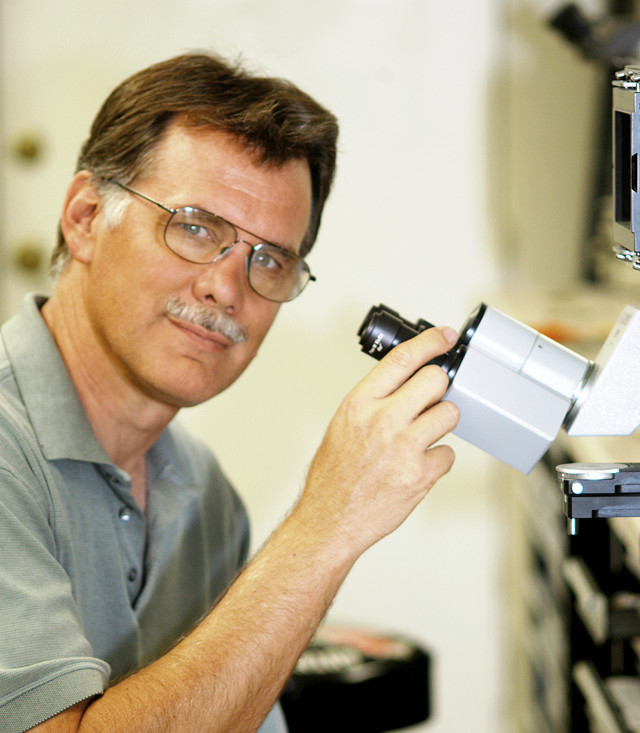
by Erin Wayman Friday, March 9, 2018

Credit: Tome Kaye.
What do paleontology, astronomy and paintball guns have in common? For one, they have all been pursuits of Tom Kaye. Kaye, a research associate at the Burke Museum in Seattle, Wash., is a self-taught paleontologist and an amateur astronomer. But he’s not content with just digging fossils and observing constellations. His ambitions are much greater. In July, for example, he set off a paleontological debate when he and his colleagues suggested in PLoS One that soft tissue that was discovered in a tyrannosaur fossil in 2005 was nothing more than bacteria trapped in tiny grooves on the bone.
Recently, Kaye spoke with EARTH associate editor Erin Wayman about his varied interests and life as an amateur in a professional’s world.
EW: How did you get involved in paleontology?
TK: I got into paleontology kind of sideways. I started reading books about new theories on dinosaurs [in the 1990s]. That led me to collaborate with some graduate students from the University of Chicago. We put together an expedition. I had the places to go out West, and they didn’t have the access or the money. So we traded, and I learned from them. Since then, they’ve all grown into positions of importance in the paleo world. I’ve kind of tagged along and learned things as I’ve gone along.
EW: What were you doing before then?
TK: In the real world, before I retired a few years ago, I was in the business of manufacturing paintball equipment. I did a lot of design and development as well as research on the physics involved.
EW: When you first started your expeditions, were you just interested in finding bones and seeing what they were?
TK: Yes, it was a treasure hunt initially, but then the science became very interesting. The science consumes a big part of what we do now.
EW: How did you make the transition from the field to the lab?
TK: I’ve been following [Mary Schweitzer’s] work for years, ever since she was a graduate student. I thought [her work on dinosaur soft tissue] was the most tremendous thing I’d seen. There were actual physical, soft, squishy tubes that you could see. That was pretty unambiguous in my mind. Mary’s team had found them after dissolving the bone in acids, but they never really looked at the bones directly. I had recently acquired my own scanning electron microscope and was looking for a project. So, I went to Mary and said I’m going to look in the bones themselves using the microscope before they’re dissolved in acid. Unfortunately, we came to completely different conclusions.
EW: Was this the first time you have ever done this sort of analysis?
TK: No. I do research in astronomy as well as paleontology — I’m only into two things, long ago and far away. [Laughs] I do a lot of spectroscopic analysis. On the astronomy side, we look at the spectrum of stars; on the paleontology side, we look at the spectrum of fossil specimens.
EW: Has astronomy also been a life-long interest?
TK: Yes, but only since the ‘90s have I been able to get a telescope to start doing work on that. That led to science because you can’t really do much [star-gazing] in Chicago where we used to live, so the only thing you could do well from Chicago was spectroscopy because the city lights don’t affect spectroscopy.
EW: You’re a member of Spectrashift. What’s that?
TK: I put together a team of high-level non-professionals and we’re attempting to be the first non-professional team to discover an extrasolar planet. We’ve already proven we can detect a [known] extrasolar planet. We started out with very crude equipment and kept improving it. The goal was to prove we could detect one of these planets by watching the shift in the frequency of light, which is very, very small. Then we actually did it and we published a professional paper on it.
EW: What is your biggest accomplishment?
TK: I’m just proud of the fact that as a non-professional I’m trying to function at the professional level. A lot of times, non-professionals will say and do crazy things that get discounted pretty quickly. I think in the case of the soft tissue … we’re coming up with the most mundane, boring explanation you can possibly imagine. I think that’s kind of different from what you usually get.
EW: Do you wish you had taken the professional route?
TK: I was on the road to becoming a scientist as a young man, and I got sidetracked in high school. Now I’m back, but I’m back on my own terms. I have a lot of friends in academia and I see that they are constantly struggling with funding and spending a lot of time applying for grants. I probably spend at least as much time on the science as they do, and I have other freedoms financially. So, I don’t know. It’s one thing to be in the academic environment and be exposed to people … talking about the same subject. On the other hand, it’s a bitch to always be fighting for money. I can’t say which way I’d rather go if I had to do it all over again.
© 2008-2021. All rights reserved. Any copying, redistribution or retransmission of any of the contents of this service without the expressed written permission of the American Geosciences Institute is expressly prohibited. Click here for all copyright requests.